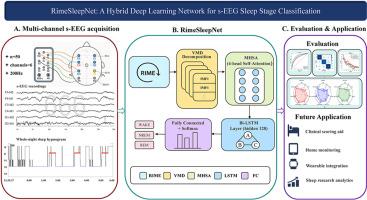RimeSleepNet: A hybrid deep learning network for s-EEG sleep stage classification
IF 3.4
2区 医学
Q1 CLINICAL NEUROLOGY
引用次数: 0
Abstract
Sleep stage classification is essential for sleep research and clinical diagnostics. However, frequency aliasing in sleep electroencephalogram (s-EEG) signals remains a significant challenge, existing methods have yet to effectively address this issue. This study proposes a hybrid deep-learning model, RimeSleepNet, comprising four key components. First, the rime optimization algorithm adaptively tunes variational mode decomposition (VMD) to reduce frequency aliasing by generating intrinsic mode functions (IMFs). Second, a convolutional neural network (CNN) automatically extracts stage-specific features from IMFs. A multi-head self-attention (MHSA) mechanism then dynamically weights these features to prioritize stage-specific patterns, followed by long short-term memory (LSTM) networks that model temporal dynamics for robust classification of NREM, REM, and WAKE stages. Evaluated on the Chengdu People's Hospital and Sleep-EDF datasets, RimeSleepNet achieves the highest F1 scores of 0.94, 0.89, and 0.92 for NREM, REM, and WAKE stages, respectively, with an AUC of 0.92, outperforming baseline models like CNN and LSTM. Cross-dataset validation confirms its robust generalization (Cohen's κ = 0.90), and it reduces validation loss by 53 % compared to LSTM, providing an advanced tool for automated sleep stage analysis in sleep disorder diagnosis and personalized monitoring.

RimeSleepNet:一种用于s-EEG睡眠阶段分类的混合深度学习网络。
睡眠阶段分类对睡眠研究和临床诊断至关重要。然而,睡眠脑电图(s-EEG)信号的频率混叠仍然是一个重大挑战,现有方法尚未有效解决这一问题。本研究提出了一种混合深度学习模型RimeSleepNet,由四个关键组件组成。首先,时间优化算法通过产生固有模态函数(IMFs)自适应调整变分模态分解(VMD)以减少频率混叠。其次,卷积神经网络(CNN)自动从imf中提取特定阶段的特征。然后,一个多头自我注意(MHSA)机制动态地权衡这些特征,优先考虑特定阶段的模式,其次是长短期记忆(LSTM)网络,该网络模拟了NREM、REM和WAKE阶段的时间动态分类。在成都市人民医院和Sleep-EDF数据集上评估,RimeSleepNet在NREM、REM和WAKE阶段的F1得分最高,分别为0.94、0.89和0.92,AUC为0.92,优于CNN和LSTM等基线模型。跨数据集验证证实了其鲁棒泛化(Cohen’s κ = 0.90),与LSTM相比,它减少了53%的验证损失,为睡眠障碍诊断和个性化监测中的自动化睡眠阶段分析提供了先进的工具。
本文章由计算机程序翻译,如有差异,请以英文原文为准。
求助全文
约1分钟内获得全文
求助全文
来源期刊

Sleep medicine
医学-临床神经学
CiteScore
8.40
自引率
6.20%
发文量
1060
审稿时长
49 days
期刊介绍:
Sleep Medicine aims to be a journal no one involved in clinical sleep medicine can do without.
A journal primarily focussing on the human aspects of sleep, integrating the various disciplines that are involved in sleep medicine: neurology, clinical neurophysiology, internal medicine (particularly pulmonology and cardiology), psychology, psychiatry, sleep technology, pediatrics, neurosurgery, otorhinolaryngology, and dentistry.
The journal publishes the following types of articles: Reviews (also intended as a way to bridge the gap between basic sleep research and clinical relevance); Original Research Articles; Full-length articles; Brief communications; Controversies; Case reports; Letters to the Editor; Journal search and commentaries; Book reviews; Meeting announcements; Listing of relevant organisations plus web sites.
 求助内容:
求助内容: 应助结果提醒方式:
应助结果提醒方式:


